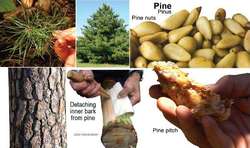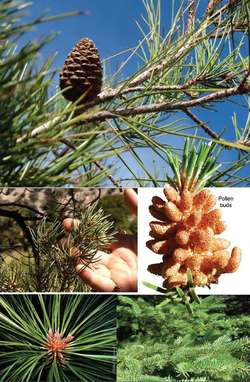pine
the wood of any of these trees
pine
1. any evergreen resinous coniferous tree of the genus Pinus, of the N hemisphere, with long needle-shaped leaves and brown cones: family Pinaceae
2. any other tree or shrub of the family Pinaceae
3. any of various similar but unrelated plants, such as ground pine and screw pine
Pine
Courtney. born 1964, British jazz saxophonist
Collins Discovery Encyclopedia, 1st edition © HarperCollins Publishers 2005
pine
A wood of a number of species of coniferous evergreens. The two classes, soft pine and hard pitch pine are an important source of construction lumber and plywood. See also: Masonite
Illustrated Dictionary of Architecture Copyright © 2012, 2002, 1998 by The McGraw-Hill Companies, Inc. All rights reserved
pine
All pine trees are edible. The whole thing- the needles, the young tiny soft (male) cones containing the pollen, the white inner bark (cambium) can be eaten raw, dried, powdered, added to soups, sauteed, steamed or boiled. One pound of inner pine bark is more nutritious than nine cups of raw whole milk. Pine nuts are super nutritious. The roots can be eaten and the root bark can be soaked in water and the water then drank as sugar water. The resin pitch gum can be chewed like gum for B vitamins and helping lung conditions. The only thing close to a pine tree being toxic is a yew tree, (not a pine tree). It's "needles" are actually soft flat thin leaves and it has tell-tale red berries with a hole in the bottom. Anyway, pine trees are one of the best sources of vitamin C in the world. Pine needles have 300x more vitamin c than oranges- also contain natural turpentines which are really good for respiratory infections- pneumonia, bronchitis. Pine bud tea is used to expel worms, help kidneys, lungs, laxative. You can munch on fresh young needles, or make a tea from them. Despite what some people say, pine tea is no threat to pregnant women. The sticky gum-resin is a great source of B-vitamins, pine nuts are an awesome source of protein, and the pollen… well... PINE POLLEN Want serious Libido, Energy and Youth ? Look no further than pine pollen. It's a true powerhouse wonder substance… a complete food and medicine. Pine Pollen is one of the ultimate superfoods in the world. It has over 200 bioacitve natural nutrients, minerals and vitamins source in one single serving, that is completely absorbed by the human body. No other nutritional supplement can do this. Pine Pollen will restore healthy levels of testosterone (without DHT). Pine pollen powder's claim to fame is the potent androgenic effect it has on the body. It contains bio-available androstenedione, testosterone, DHEA, androsterone and a wide variety of other steroidal type substances (which unlike synthetic steroids, these are perfectly safe)! These anabolic compounds not only help build muscle mass, they keep the skin smooth and tight, maintain a healthy libido, optimize tissue regeneration, optimize breast health in women and testicular and prostate health in men, aid in the excretion of excess estrogens and speed up the metabolism to help burn off excess fat. Since it's a complete superfood, it affects pretty much the entire body... lungs, immune system, skin, kidneys, brain, hair, bones, endocrine, liver regeneration, bile secretion, heart, increases cardiovascular endurance, raises blood levels of Superoxide Dismutase (SOD) perhaps the most powerful and crucial antioxidant the body makes, lowers cholesterol, spleen... all in the direction of anti-aging. Pine pollen stabilizes collagen and elastin, which make up the underlying matrix of the skin, thus preventing wrinkles. Pine pollen balances hormones. The phyto-androgens in pine pollen help to counter the effects of estrogen mimicking substances that we are exposed to more and more of like plastic bottles, food containers, body care products, cleaners, medications, plastics, dairy products and more can mimic estrogens in our bodies and lead to hair loss and Pine pollen is more stimulating and energizing than coffee without the caffeine or stimulants. It’s 30% protein. Increases sexual power in both men and women. Less recovery time from gym and less sleep. Helps nourish skin and hair, clears brain fog, removes age spots. Rutin, one of the components of pine pollen, increases the strength of the capillary vessels and helps protect the cardiovascular system, heart, blood and blood vessels. Pine pollen is 99% digestible, much more than bee pollen. Over 20 Amino Acids and 8 Essential Amino Acids Making Pine Pollen A Complete Protein: Alanine, Arginine, Aspartic, Cysteine, Glutamic, Acid, Glycine, Histidine,Isoleucine, Leucine, Lysine, Methionine, Phenylalanie, Proline, Serine, Threonine, Tryptophan, Tyrosine, Valine. Some people are allergic to pollen (a sign the liver needs cleaning and adrenals need rebuilding), so take a tiny bit first (1/8 tsp) and see how you react. Gradually build up as your body adapts to its potency. Recommended Usage: one spoonful twice daily. You can harvest your own pine pollen. Find out what time of year in your area the pine trees pollinate (when yellow powder coats everything). Usually mid April for northern countries. You can place the bag over the ends of the pine tree branches and gently knock the cones to get the pine pollen yellow powder to fall off into the bag. PINE, SPRUCE or FIR TREE PITCH - GUM- RESIN When a pine tree is injured, it secretes resin, which is a protective antiseptic, full of B vitamins. It’s very sticky and hard to get off skin, so it's good for sealing wounds together, and keep it sterile because it's an antiseptic. It will stick to your teeth until it dissolves, leaving your teeth white again. It can be used as glue, and can be taken off with oils or butter. It’s actually been used to seal root canals! Chew and swallow small pieces- helps bring phlegm up out of lungs (expectorant). PINE BARK has Pycnogenol- a highly active bioflavonoid. It doubles blood vessel strength, improves circulation, joint flexibility, defend collagen destruction, varicose veins, hemorrhoids, protect brain cells and slow the aging process. It strengthens the entire arterial system. Used in Europe as an "oral cosmetic" because it stimulates collagen-rich connective tissue against atherosclerosis and helps joint flexibility. It is one of the few dietary antioxidants that crosses the blood-brain barrier to directly protect brain cells. (Pycnogenol is also found in grape seed extract) PINE NUTS are an amazing food source, used by indians, birds and squirrels. Indians used pine nut soup as a replacement for mothers milk! Lost in the woods? The Eastern white pine (the one with the long needles) can help you find your way. It always has a big huge diagonal branch pointing EAST. Is the Australian Pine edible? Yes.
Edible Plant Guide © 2012 Markus Rothkranz
pine
[′pīn] (botany)
Any of the cone-bearing trees composing the genus Pinus; characterized by evergreen leaves (needles), usually in tight clusters of two to five.
McGraw-Hill Dictionary of Scientific & Technical Terms, 6E, Copyright © 2003 by The McGraw-Hill Companies, Inc.
pine
The wood of a number of species of coniferous evergreen distributed throughout the world; may be divided into two classes: soft (white) pine and hard (pitch) pine. An important source of construction lumber and plywood.
McGraw-Hill Dictionary of Architecture and Construction. Copyright © 2003 by McGraw-Hill Companies, Inc.
Pine
Program for Internet News & Email. A tool for reading,
sending, and managing electronic messages. It was designed
specifically with novice computer users in mind, but can be
tailored to accommodate the needs of "power users" as well.
Pine uses Internet message protocols (e.g. RFC 822,
SMTP, MIME, IMAP, NNTP) and runs under Unix and
MS-DOS.
The guiding principles for Pine's user-interface were: careful limitation of features, one-character mnemonic commands, always-present command menus, immediate user feedback, and high tolerance for user mistakes. It is intended that Pine can be learned by exploration rather than reading manuals. Feedback from the University of Washington community and a growing number of Internet sites has been encouraging.
Pine's message composition editor, Pico, is also available as a separate stand-alone program. Pico is a very simple and easy-to-use text editor offering paragraph justification, cut/paste, and a spelling checker.
Pine features on-line help; a message index showing a message summary which includes the status, sender, size, date and subject of messages; commands to view and process messages; a message composer with easy-to-use editor and spelling checker; an address book for saving long complex addresses and personal distribution lists under a nickname; message attachments via Multipurpose Internet Mail Extensions; folder management commands for creating, deleting, listing, or renaming message folders; access to remote message folders and archives via the Interactive Mail Access Protocol as defined in RFC 1176; access to Usenet news via NNTP or IMAP.
Pine, Pico and UW's IMAP server are copyrighted but freely available.
Unix Pine runs on Ultrix, AIX, SunOS, SVR4 and PTX. PC-Pine is available for Packet Driver, Novell LWP, FTP PC/TCP and Sun PC/NFS. A Microsoft Windows/WinSock version is planned, as are extensions for off-line use.
Pine was originally based on Elm but has evolved much since ("Pine Is No-longer Elm"). Pine is the work of Mike Seibel, Mark Crispin, Steve Hubert, Sheryl Erez, David Miller and Laurence Lundblade (now at Virginia Tech) at the University of Washington Office of Computing and Communications.
ftp://ftp.cac.washington.edu/mail/pine.tar.Z. telnet://demo.cac.washington.edu/ (login as "pinedemo").
E-mail: <pine@cac.washington.edu>, <pine-info-request@cac.washington.edu>, <pine-announce-request@cac.washington.edu>.
The guiding principles for Pine's user-interface were: careful limitation of features, one-character mnemonic commands, always-present command menus, immediate user feedback, and high tolerance for user mistakes. It is intended that Pine can be learned by exploration rather than reading manuals. Feedback from the University of Washington community and a growing number of Internet sites has been encouraging.
Pine's message composition editor, Pico, is also available as a separate stand-alone program. Pico is a very simple and easy-to-use text editor offering paragraph justification, cut/paste, and a spelling checker.
Pine features on-line help; a message index showing a message summary which includes the status, sender, size, date and subject of messages; commands to view and process messages; a message composer with easy-to-use editor and spelling checker; an address book for saving long complex addresses and personal distribution lists under a nickname; message attachments via Multipurpose Internet Mail Extensions; folder management commands for creating, deleting, listing, or renaming message folders; access to remote message folders and archives via the Interactive Mail Access Protocol as defined in RFC 1176; access to Usenet news via NNTP or IMAP.
Pine, Pico and UW's IMAP server are copyrighted but freely available.
Unix Pine runs on Ultrix, AIX, SunOS, SVR4 and PTX. PC-Pine is available for Packet Driver, Novell LWP, FTP PC/TCP and Sun PC/NFS. A Microsoft Windows/WinSock version is planned, as are extensions for off-line use.
Pine was originally based on Elm but has evolved much since ("Pine Is No-longer Elm"). Pine is the work of Mike Seibel, Mark Crispin, Steve Hubert, Sheryl Erez, David Miller and Laurence Lundblade (now at Virginia Tech) at the University of Washington Office of Computing and Communications.
ftp://ftp.cac.washington.edu/mail/pine.tar.Z. telnet://demo.cac.washington.edu/ (login as "pinedemo").
E-mail: <pine@cac.washington.edu>, <pine-info-request@cac.washington.edu>, <pine-announce-request@cac.washington.edu>.
This article is provided by FOLDOC - Free Online Dictionary of Computing (foldoc.org)


